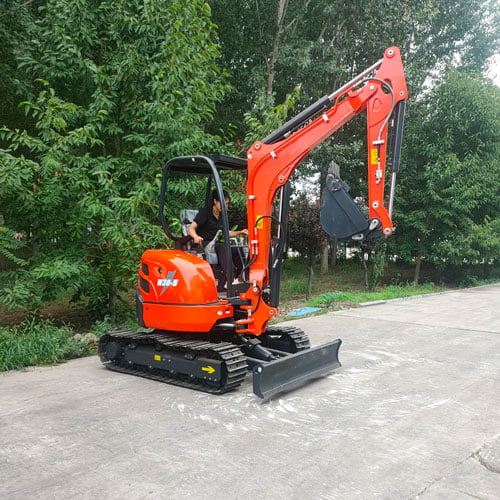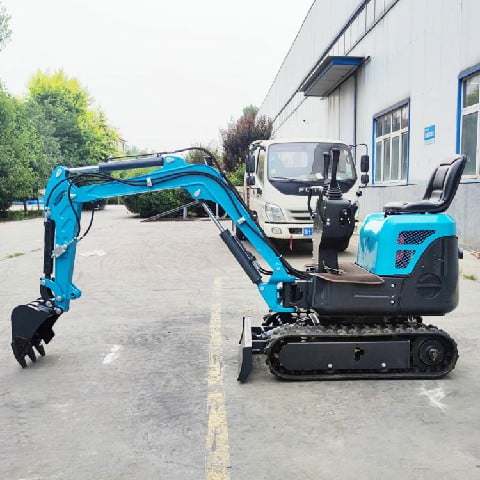Introduction
Mini compact excavators have become an essential piece of equipment in various industries, including construction, landscaping, and agriculture. These versatile machines are prized for their ability to perform a wide range of tasks in confined spaces. However, choosing the best mini compact excavator for your needs can be challenging due to the numerous models and features available. This comprehensive guide will help you navigate the selection process, providing insights into the key factors to consider, benefits, and maintenance tips. By the end of this guide, you’ll have a thorough understanding of how to choose the best mini compact excavator for your projects.
Understanding Mini Compact Excavators

What is a Mini Compact Excavator?
A mini compact excavator, also known as a mini excavator or compact excavator, is a small, versatile machine equipped with a boom, dipper, and bucket. It is designed to perform excavation tasks in tight spaces where larger excavators cannot operate. These machines are commonly used for digging, trenching, grading, and demolition work.
- Definition: A small, versatile excavation machine.
- Components: Boom, dipper, and bucket.
- Common Uses: Digging, trenching, grading, and demolition.
Benefits of Using a Mini Compact Excavator
Mini compact excavators offer several benefits that make them a popular choice for various projects. These benefits include:
- Versatility: Capable of performing multiple tasks with different attachments.
- Maneuverability: Ideal for working in confined spaces.
- Efficiency: Faster and more efficient than manual labor.
- Cost-Effective: Lower operating costs compared to larger excavators.
- Ease of Use: User-friendly controls and simple operation.
Types of Mini Compact Excavators
There are different types of mini compact excavators available, each designed for specific tasks and conditions. Understanding the types can help you choose the best machine for your needs.
- Zero Tail Swing: Ideal for working in tight spaces with minimal overhang.
- Conventional Tail Swing: Offers more stability and lifting capacity.
- Long Reach: Designed for tasks requiring extended reach.
- High Flow: Equipped with enhanced hydraulics for operating high-demand attachments.
Key Factors to Consider When Choosing a Mini Compact Excavator
Project Requirements
Understanding your project requirements is the crucial first step in selecting the most suitable mini compact excavator. Begin by identifying the specific tasks you need to accomplish, such as digging, trenching, or grading. Next, assess the working conditions, including the type of terrain, space constraints, and any potential obstacles you might encounter on-site. Additionally, evaluate the overall scope of the project, considering factors such as project duration, the size of the area to be worked on, and the frequency of use. By thoroughly analyzing these aspects, you can ensure that the mini compact excavator you choose will meet your project’s demands effectively and efficiently.
- Task Type: Identify the primary tasks (e.g., digging, trenching, grading).
- Working Conditions: Assess the terrain and space constraints.
- Project Scope: Determine the size and duration of the project.
Size and Weight
The size and weight of the mini compact excavator are crucial factors that affect its performance and suitability for specific tasks. Choose a machine that can navigate your work site and handle the required load.
- Machine Size: Ensure it fits in the working space.
- Operating Weight: Check if it can handle the load without compromising stability.
- Transportability: Consider the ease of transporting the machine to different sites.
Engine Power and Performance
Engine power determines the machine’s capability to perform heavy-duty tasks. Evaluate the engine specifications and performance to ensure the mini compact excavator meets your needs.
- Horsepower: Higher horsepower for demanding tasks.
- Fuel Efficiency: Look for fuel-efficient models to reduce operating costs.
- Emission Standards: Ensure compliance with local emission regulations.
Hydraulic System
The hydraulic system is critical for the mini compact excavator’s performance. It powers the attachments and ensures smooth operation. Check the hydraulic flow rate and pressure to match the requirements of your tasks.
- Flow Rate: Adequate flow rate for operating attachments.
- Pressure: Ensure sufficient pressure for efficient operation.
- Auxiliary Hydraulics: Look for models with auxiliary hydraulics for added versatility.
Attachments and Versatility
One of the significant advantages of mini compact excavators is their ability to use various attachments. Consider the available attachments and the machine’s versatility to handle different tasks.
- Bucket Types: Different buckets for digging, grading, and trenching.
- Other Attachments: Augers, breakers, thumbs, and grapples.
- Attachment Compatibility: Ensure the machine can accommodate various attachments.
Table: Comparison of Key Features in Mini Compact Excavators
| Feature | Description | Importance |
|---|---|---|
| Engine Power | Horsepower and fuel efficiency | Determines performance and cost |
| Hydraulic System | Flow rate and pressure | Ensures smooth operation and versatility |
| Size and Weight | Machine dimensions and operating weight | Affects maneuverability and stability |
| Attachments | Variety and compatibility of attachments | Enhances versatility and functionality |
| Operating Controls | User-friendly controls and features | Affects ease of use and precision |
| Maintenance Requirements | Regular maintenance needs and costs | Influences long-term reliability |
Choosing the Right Attachments
Types of Attachments
Selecting the right attachments for your mini compact excavator can significantly enhance its functionality. Here are some common attachments and their uses:
- Buckets: For digging, trenching, and grading.
- Augers: For drilling holes in the ground.
- Breakers: For demolishing concrete and rocks.
- Thumbs: For grasping and lifting objects.
- Grapples: For handling debris and materials.
Compatibility and Quick Couplers
Ensure that the attachments you choose are compatible with your mini compact excavator. Quick couplers can facilitate easy and fast attachment changes, improving productivity.
- Compatibility: Check the attachment mount and hydraulic requirements.
- Quick Couplers: Allow for rapid attachment changes without tools.
Attachment Maintenance
Regular maintenance of attachments is essential for their longevity and performance. Follow the manufacturer’s guidelines for cleaning, lubrication, and inspection.
- Cleaning: Remove dirt and debris after each use.
- Lubrication: Apply lubricant to moving parts.
- Inspection: Check for wear and damage regularly.
Maintenance Tips for Mini Compact Excavators

Regular Inspection and Servicing
Regular inspection and servicing are crucial for keeping your mini compact excavator in optimal condition. Create a maintenance schedule and stick to it.
- Daily Checks: Inspect for leaks, check fluid levels, and examine the tracks.
- Scheduled Servicing: Follow the manufacturer’s service intervals for oil changes, filter replacements, and other maintenance tasks.
Proper Storage
Store your mini compact excavator in a dry, covered area to protect it from the elements. Proper storage can prevent rust and extend the lifespan of the machine.
- Covered Storage: Keep the machine in a sheltered area.
- Clean Before Storage: Remove dirt and debris before storing.
Operator Training
Proper operator training is essential for safe and efficient operation. Ensure that all operators are trained and familiar with the machine’s controls and safety features.
- Training Programs: Provide comprehensive training for all operators.
- Safety Guidelines: Ensure operators follow safety protocols and guidelines.
Conclusion
Choosing the best mini compact excavator requires careful consideration of various factors, including project requirements, machine size, engine power, hydraulic system, and available attachments. By understanding these key aspects and following proper maintenance practices, you can ensure that your mini compact excavator performs optimally and meets your project needs. Whether you are involved in construction, landscaping, or agriculture, selecting the right mini compact excavator can enhance your productivity and efficiency.
FAQ
What is a mini compact excavator used for?
A mini compact excavator is used for various tasks, including digging, trenching, grading, and demolition. It is ideal for working in confined spaces where larger excavators cannot operate.
How do I choose the right size mini compact excavator?
To choose the right size mini compact excavator, consider your project requirements, working conditions, and space constraints. Ensure the machine can navigate your work site and handle the required load.
What factors should I consider when selecting a mini compact excavator?
Key factors to consider include project requirements, machine size and weight, engine power and performance, hydraulic system, and available attachments. These factors will help you choose the best machine for your needs.
How often should I service my mini compact excavator?
Regular servicing is crucial for maintaining the performance and longevity of your mini compact excavator. Follow the manufacturer’s service intervals for oil changes, filter replacements, and other maintenance tasks.
What attachments are available for mini compact excavators?
Common attachments for mini compact excavators include buckets, augers, breakers, thumbs, and grapples. These attachments enhance the machine’s versatility and functionality for different tasks.
Can I use a mini compact excavator in confined spaces?
Yes, mini compact excavators are designed for working in confined spaces. Their compact size and maneuverability make them ideal for tasks in tight areas.
What is the importance of engine power in a compact excavator?
Engine power determines the machine’s capability to perform heavy-duty tasks. Higher horsepower provides better performance and efficiency, especially for demanding applications.
How do I maintain the attachments for my compact excavator?
Regular maintenance of attachments includes cleaning, lubrication, and inspection. Follow the manufacturer’s guidelines to ensure the longevity and performance of the attachments.
Are compact excavators cost-effective?
Yes, compact excavators are cost-effective due to their lower operating costs compared to larger excavators. They offer versatility, efficiency, and ease of use, making them a valuable investment for various projects.
What safety precautions should I take when operating a compact excavator?
Safety precautions include proper operator training, following safety protocols, performing regular machine inspections, and using the machine within its specified limits. Always wear appropriate safety gear and follow the manufacturer’s guidelines.




